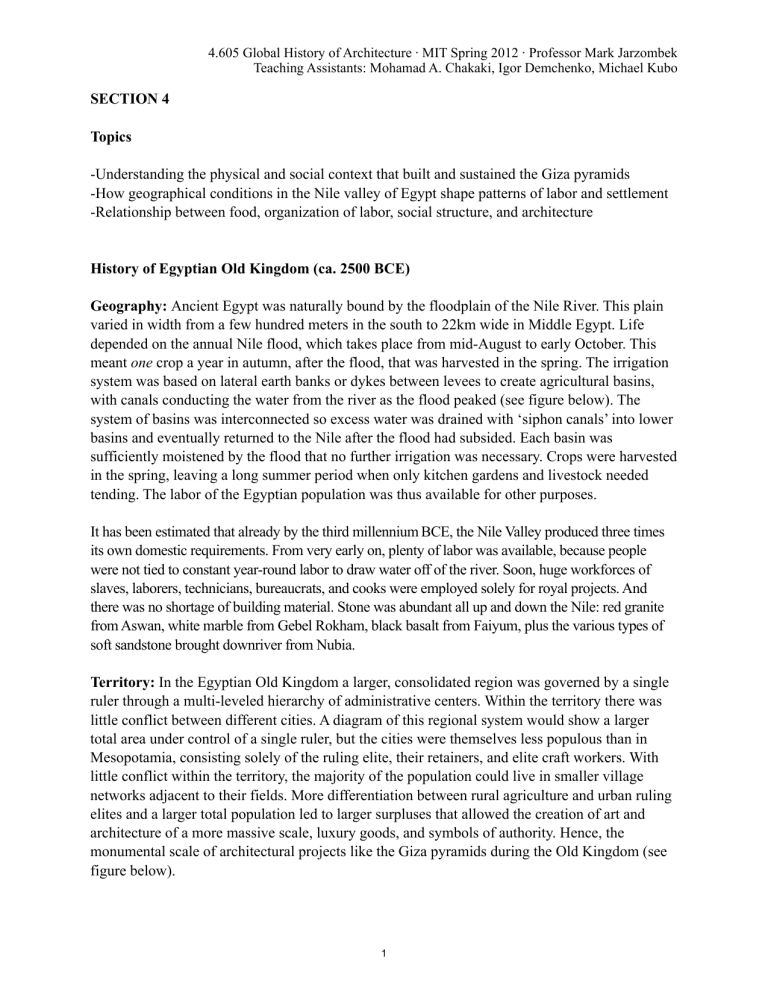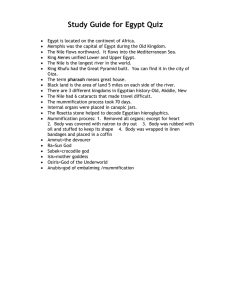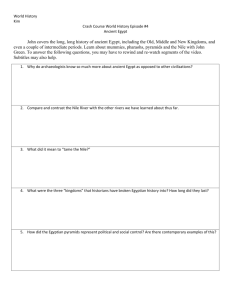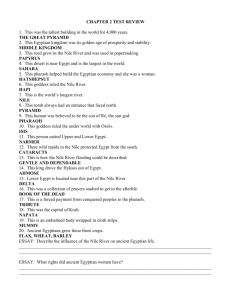4.605 Global History of Architecture · MIT Spring 2012 ·... Teaching Assistants: Mohamad A. Chakaki, Igor Demchenko, Michael Kubo

4.605 Global History of Architecture · MIT Spring 2012 · Professor Mark Jarzombek
Teaching Assistants: Mohamad A. Chakaki, Igor Demchenko, Michael Kubo
SECTION 4
Topics
-Understanding the physical and social context that built and sustained the Giza pyramids
-How geographical conditions in the Nile valley of Egypt shape patterns of labor and settlement
-Relationship between food, organization of labor, social structure, and architecture
History of Egyptian Old Kingdom (ca. 2500 BCE)
Geography: Ancient Egypt was naturally bound by the floodplain of the Nile River. This plain varied in width from a few hundred meters in the south to 22km wide in Middle Egypt. Life depended on the annual Nile flood, which takes place from mid-August to early October. This meant one crop a year in autumn, after the flood, that was harvested in the spring. The irrigation system was based on lateral earth banks or dykes between levees to create agricultural basins, with canals conducting the water from the river as the flood peaked (see figure below). The system of basins was interconnected so excess water was drained with ‘siphon canals’ into lower basins and eventually returned to the Nile after the flood had subsided. Each basin was sufficiently moistened by the flood that no further irrigation was necessary. Crops were harvested in the spring, leaving a long summer period when only kitchen gardens and livestock needed tending. The labor of the Egyptian population was thus available for other purposes.
It has been estimated that already by the third millennium BCE, the Nile Valley produced three times its own domestic requirements. From very early on, plenty of labor was available, because people were not tied to constant year-round labor to draw water off of the river. Soon, huge workforces of slaves, laborers, technicians, bureaucrats, and cooks were employed solely for royal projects. And there was no shortage of building material. Stone was abundant all up and down the Nile: red granite from Aswan, white marble from Gebel Rokham, black basalt from Faiyum, plus the various types of soft sandstone brought downriver from Nubia.
Territory: In the Egyptian Old Kingdom a larger, consolidated region was governed by a single ruler through a multi-leveled hierarchy of administrative centers. Within the territory there was little conflict between different cities. A diagram of this regional system would show a larger total area under control of a single ruler, but the cities were themselves less populous than in
Mesopotamia, consisting solely of the ruling elite, their retainers, and elite craft workers. With little conflict within the territory, the majority of the population could live in smaller village networks adjacent to their fields. More differentiation between rural agriculture and urban ruling elites and a larger total population led to larger surpluses that allowed the creation of art and architecture of a more massive scale, luxury goods, and symbols of authority. Hence, the monumental scale of architectural projects like the Giza pyramids during the Old Kingdom (see figure below).
1
4.605 Global History of Architecture · MIT Spring 2012 · Professor Mark Jarzombek
Teaching Assistants: Mohamad A. Chakaki, Igor Demchenko, Michael Kubo
Architecture and Food: For Egyptian society (and not unlike those of Mesopotamia), food was not only the sustenance of humans but also of the gods. In the Old Kingdom, offerings of food were laid out on an “offering table” in front of the Ka statue in the mortuary temple at the base of the pyramid, in order to provide for the difficult journey that lay ahead. Offerings consisted of meat, roasted fowl, bread, fruit, vegetables, beer, and wine, all delivered out of the temple’s own agricultural estates.
Whereas the Mesopotamians rarely sacrificed animals, which were not plentiful in the alluvial plain, for the Egyptians animal sacrifices were not uncommon, with offerings—especially of gazelles, antelopes, geese, ducks, and pigeons—coming mainly from hunting. The Egyptians did not perform the actual killing and bloodletting in “sight” of the gods; the Ka was visualized as alive and sensitive, or at least as coaxed back to life by tasty morsels.
Images removed due to copyright restrictions.
1) Fig. 14.2 in Trigger, B. G.
Understanding Early Civilizations
.
2) Fig. 2.2 in Trigger, B. G., et al.
Ancient Egypt
.
Additional Bibliography
—Barry Kemp, Ancient Egypt: Anatomy of a Civilization , 2nd ed. (Routledge, 2006).
—Bruce Trigger, Understanding Early Civilizations: A Comparative Study (Cambridge
University Press, 2003).
—Trigger et al., Ancient Egypt: A Social History (Cambridge University Press, 1983).
2
MIT OpenCourseWare http://ocw.mit.edu
4.605 Introduction to the History and Theory of Architecture
Spring 201 2
For information about citing these materials or our Terms of Use, visit: http://ocw.mit.edu/terms .





